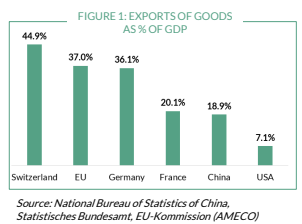Prof. Dr. Jan Viebig, Global Co-CIO ODDO BHF AM.
“That said, Germany’s reliance on American consumers remains limited—what matters far more is the free movement of goods within the European Union.”
Boosted by the adoption of a historic financial package that promises large-scale public investment, the German stock market was recently shaken by mounting uncertainty over steep US import tariffs. Since the beginning of the year, the DAX had gained more than 13 percent, only to plunge by around 10 percent at market opening on 7 April following Trump’s sweeping tariff announcement.
On the one hand, the justified hopes for an economic recovery offer a glimmer of hope for Germany’s stagnating economy. On the other hand,external risks—particularly the prospect of rising global trade restrictions—are weighing heavily on the country’s economic outlook.
Tariffs as a risk factor
The announcement of US tariffs on European imports puts Germany’s export-driven economy to the test. Goods exports account for 36.1 percent of German GDP (source: Statistisches Bundesamt), making the country particularly vulnerable to rising trade barriers. In comparison, the export share is just 7.1 percent in the US and 18.9 percent in China.

Germany’s economic growth is therefore currently largely based on free trade and global value chains.
Germany’s export orientation is considered as a sign of economic strength and the competitiveness of German companies. However, following the Trump administration’s decision to adopt a radical tariff policy, Germany’s high dependence on exports has increasingly become a burden on growth.




